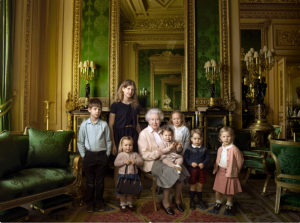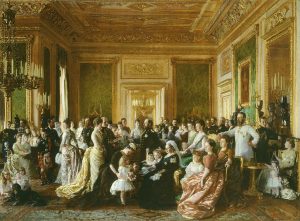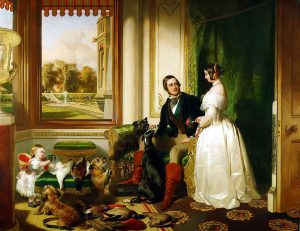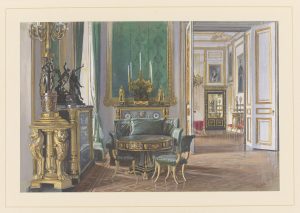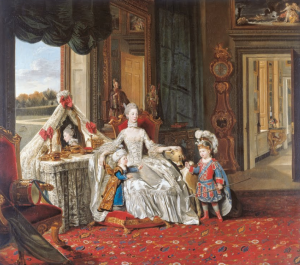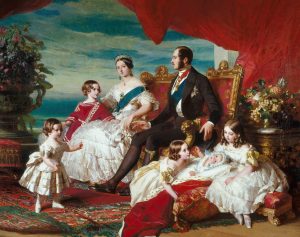The Queenly Interior
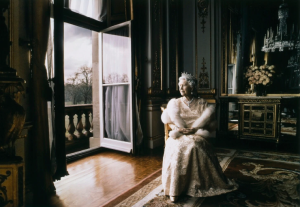
Annie Leibovitz, Queen Elizabeth II, chromogenic print, 2007. National Portrait Gallery, photo courtesy of the artist.
As most followers of Home Subjects are aware, our all three members of our core team (Morna O’Neill, Melinda McCurdy, and Anne Nellis Richter) specialize in the history of British Art, working on material that ranges from the mid-eighteenth century up through the early twentieth. As a result, HM Queen Elizabeth II (1926-2022) is a figure who has long stood at the periphery of our work lives. While none of us explicitly works on any topic later than the Edwardian period, the Queen’s persistent presence as a figurehead through the length of all of our lives and careers represents a curious thread connecting present with past. As we have grappled with themes of empire, race, class, gender, and representation in British culture of the last 250+ years, it has been impossible to ignore the way in which current events have so frequently rhymed with ones long past (the death and funeral of Princess Diana in 1997, for example, seemed to have been eerily prefigured by the scandals, relentless press houndings, divorce trial, and finally, national outpouring of grief after the death of King George IV’s wife, Queen Caroline, in 1821.) So with the accession of King Charles III, we update our mental timelines and watch for the historical ripples to continue spreading outward. To mark this passage, we are sharing these brief thoughts on queenly representation, and of course, the role that interiors have played in shaping the public’s image of who these British queens are and how we are supposed to understand them as emblematic of state and imperial power and as examplars of womanly virtue. (To automatically receive future posts in your in-box, please go to the home page and scroll down to the bottom to find the box where you can subscribe using your email address.)
Queen Elizabeth II was photographed by Annie Leibovitz in 2016 to mark her 90th birthday, and the photo that circulated most widely in the media at the time played upon the image of the Queen as a grandmother. Leibovitz pictured her seated in the iconic Green Drawing Room at Windsor Castle, which was fitted by royal cabinetmakers Morel & Seddon in the 1820s-1830s. The Queen is pictured surrounded by two of her youngest grandchildren and several great-grandchildren, gathered in picturesque groupings of three and looking attentively at the viewer. The watercolor and bodycolor elevation the cabinetmakers provided for their design suggests a room flooded with natural light, with expansive views over the landscape surrounding Windsor Castle, as seen from its elevated position. But Leibovitz’s photograph imagines the room as an interior world. The mirror behind her reflects the room multiple times while cleverly eliding the presence of the photographer. There is little sense of a world outside this room; scant natural light enters from the left of the image, where the edge of a green velvet curtain peeps into view.
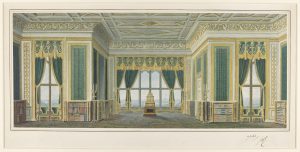
Office of Morel & Seddon, Design for the east elevation of the Library 9the Green Drawing Room), Windsor Castle, c. 1826. Royal Collection Trust.
The photograph denies any hint of public life, responsibility, or anything outside of its frame, focusing the viewer instead on a woman surrounded by children. There is the implication that she is “just a grandmother,” as a student in one of my classes once asserted, rather than a person who in practice exercises considerable influence over the lives of people in all Commonwealth countries, as indirect, diffuse, and resistant to interpretation as that influence can often be. In an official portrait made in 2007 at Buckingham Palace, Leibovitz positions the monarch next to an open French door, looking out over the landscape. But here too, the emphasis is on the interior, and the view appears to reference traditions of hortus conclusus, which would characterize the Queen as a woman first, and only secondly as a representative of state power, or a figure of the modern world.
In both of these photographs, Leibovitz engages with tropes of Queenly representation that may be traced back though many generations. In 1887, Danish portraitist Laurits Regner Tuxen painted the family of Queen Victoria–a cast of people that numbers dozens–in the same Green Drawing Room. Tuxen’s portrait by necessity shows the room from an angle that emphasizes just how large it is, but similarly, the Queen sits with grandchildren surrounding her, one presenting her with a bouquet of flowers. When she ascended to the throne in 1837, Victoria was the first female sovereign in over a century. The last had been Queen Anne who reigned from 1702-1714, during which time the Acts of Union united the kingdoms of England and Scotland into a single state known as Great Britain. The Britain of 1837 was a very different place, and it was thought vital that Victoria maintain an image as a devoted wife and mother even as she reigned over (and encouraged the expansion of) a rapidly growing empire.
Fittingly, a portrait of Victoria made by Edwin Landseer much earlier in her reign offers a vision of motherly (and importantly, wifely) duty and interiority. This portrait, titled Windsor Castle in Modern Times, depicts Victoria gazing devotedly at her husband. She outranks him, as the position of her head slightly above his acknowledges, but his seated position anchors the family structure. Despite the prominent green drapery, this portrait was made in the adjacent White Drawing Room at Windsor, which had been fitted by Morel & Seddon at the same time, and leaves the impression of a smaller space, focusing on a corner next to a window overlooking the East Terrace, a sunken section of garden with a fountain in the center.
The domestic scale the image implies would have been far more relatable to the middle-class viewers who bought engravings made after this painting to display in their own interiors. At the left of the composition, the eldest of what would eventually be their nine children plays with the game her father has brought back from a day’s hunting; above her head, a window frames a view of a formal garden, a motif that Leibovitz employed in the official portrait mentioned above.
These tropes of the dual roles of motherhood and queenship continue to rhyme as we move further back into the past. Johann Zoffany’s portrait of Queen Charlotte, the consort of George III, with her two eldest sons (she went on to have fifteen children, outdoing even Victoria), offer yet another precedent for Leibovitz’s positioning of the Queen next to a window with a view onto a landscape. There is of course an important distinction to be made between Charlotte and the other Queens described in this post, which is that she was consort to King George III–and so therefore her role was quite discrete and her image never needed to bear the weight of the dual roles that burdened the public images of queens regnant (despite Charlotte’s sudden recent popularity thanks to the prominence of her character in the refreshingly revisionist Netflix series Bridgerton). It is her sons who will inherit the mantle of royal power, and their mother’s role is to shape them as wise and just rulers (in the case of George IV, pictured here as a boy in Roman costume, it would have been widely agreed at the time that she failed miserably). In Zoffany’s portrait, mirrors again play a critical role in the representation of the Queen. She is reflected first and most obviously in the mirror on the dressing table, which transforms her into a profile view recalling commemmorative medals and other objects on which her image would have been recorded. Behind her, another mirror is depicted hanging over a pier table, which reflects the interior back onto itself, making visible the back side of the door and reversing the image of the overdoor painted panels that surmount it. The open door permits the viewer a glance at a third mirror in the next room down the enfilade, in which he or she glimpses a maid in black and white, who can presumably see the Queen, and us, reflected back to her as well. Queen Charlotte is watched by the maid, by the Chinese figures on the table behind her, her two sons and the dog at her knee; even the figure atop the French clock behind her seems aware of her presence. The multiple lines of sight, augmented by the mirrors on display, remind viewers that there is really no space in which a Queen is ever not on view.
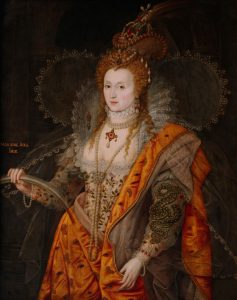
Isaac Oliver or Marcus Gheeraerts the Younger, attr. The Rainbow Portrait of Queen Elizabeth I, c. 1600-1602. Collection of the Marquess of Salisbury, Hatfield House. Image courtesy of wikimedia commons.
Prior to Queen Charlotte, the two queens with the most visible public images were Anne and Elizabeth I. Famously, neither woman ever gave birth to surviving children, and their images were presented in the tradition that was at that time more expected for a monarch. In the case of Elizabeth I, these portraits, which were many and all of which are fascinating, took the form of iconic imagery which abstracted the Queen into a series of signs and symbols of the absolute authority that she then represented. In one portrait made toward the end of her life, known as The Rainbow Portrait, she appears eternally youthful, delicately grasping a rainbow with her right hand, suggesting her god-ordained ability to control nature and the heavens, and everything under their purview. The Latin inscription next to it, Non Sine Sole Iris, “no rainbow without a sun,” reminds viewers that without the sunlight bestowed by the divine light of the Queen, the rainbow that is England would not exist.
Over the course of the 200 subsequent years, however, Britons’ world changed to the extent that such a vision of divine and wholly unaccountable royal authority could not persist. A free and rambunctious press, the ever-increasing encroachment of British business interests accompanied by military intervention around the globe, and increasingly expanding and confident middle class, dictated shifts in the expression of royalty that nodded to the need for public support for its continued existence. It would seem that especially after Victoria, it is difficult to show the Queen in an interior without referencing motherhood. Franz Xaver Winterhalter’s family portrait made in 1846, only a few years after Landseer’s, seems to take abundance of children as its animating principle, the Queen surrounded by five children under the age of seven, more goddess borne aloft by cherubs in voluminous satin dresses than human mother.
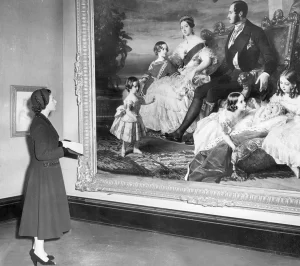
The Queen standing before Royal Family, by Franz Winterhalter, on loan to the Royal Academy’s Kings and Queens AD653-1953 exhibition at Burlington House, London, 1953. Courtesy of Keystone/Getty Images.
By the mid-20th century, when Elizabeth II came to the thone and the privations of World War II were still in recent memory, a depiction of royal motherhood such as Winterhalter’s would have been too ridiculous to bear contemplation. A photograph of Queen Elizabeth attending an exhbiition at the Royal Academy in 1953, shortly after she herself became Queen, depicts her looking at Winterhalter’s portrait. Elizabeth had two of her own children by the time this picture was taken, so what could she possibly have made of her great-great-grandmother’s example, seated as she was on a terrace with a view of the sea theatrically draped with a red curtain?
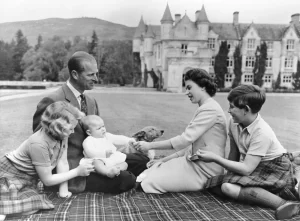
Queen Elizabeth II and Prince Phillip, with Prince Charles, Princess Anne, and Prince Andrew as a baby, c. 1960.
A photograph taken circa 1960 depicts the Queen, her husband, and older children Charles and Anne on a picnic blanket with their new baby, who was the third of what would eventually be four royal children. Such ‘candid’ snapshots of the royal family, which prefigured the infamous 1969 BBC fly-on-the-wall documentary The Royal Family, appealed to a more modern sensibility in which British people wished to feel that the royals were simultaneously symbols of continuity with the past and ‘regular’ people, whatever that could possibly mean. Even as these efforts at a more ‘human’ face to monarchy made in the 1960s appeared to prefigure the early internet and social media eras, they were ulimately unable to withstand the onslaught of paparazzi imagery and mounting scandal. It seems that as Leibovitz captured (and rehabilitated) the image of these people in the 21st century, she re-energized the tropes of the eighteenth- and nineteenth-centuries, ensconcing the Queen and her grandchildren back into a familiar domestic space and evacuating them of particularity and personality, allowing each viewer to project upon them the image of royalty he or she wishes to see. The evolving image of King Charles III and subsequent generations of royalty–however long the monarchy should last–will be fascinating to watch.
